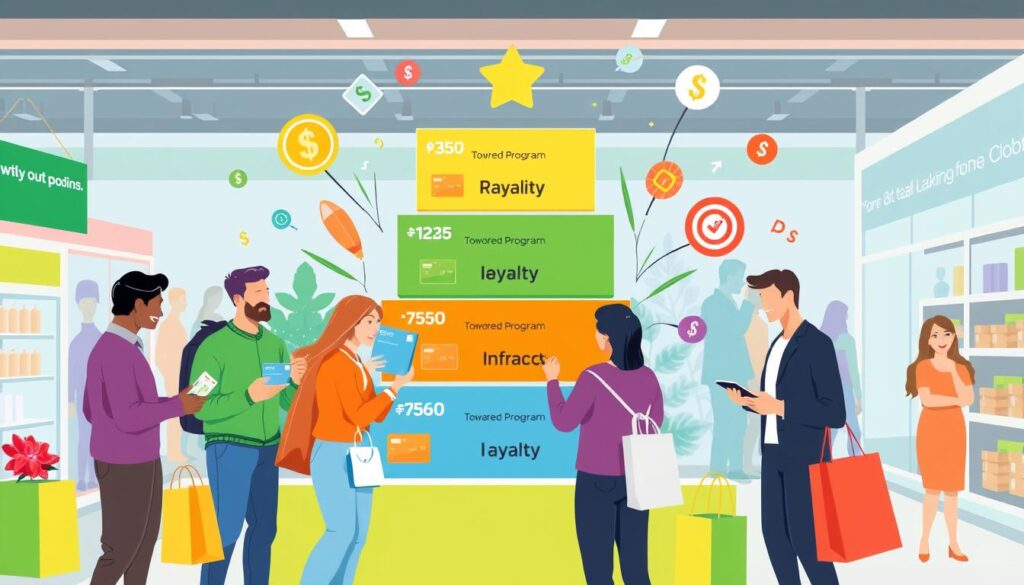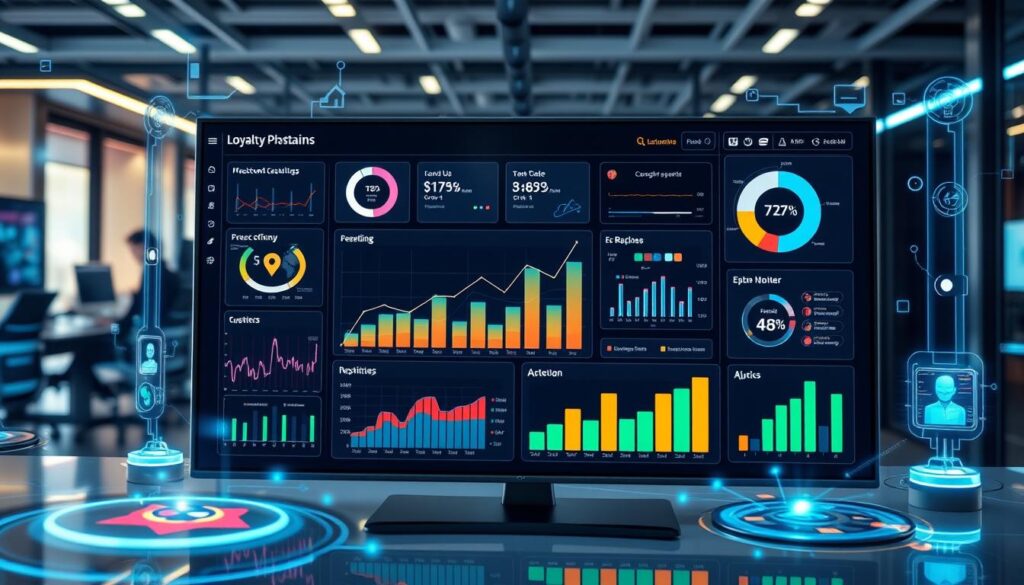Building a strong customer loyalty program is crucial for any business looking to increase customer retention and drive revenue growth. With 79% of consumers saying that customer loyalty programs make them more likely to continue doing business with a brand, it’s clear that these programs are a key component of any successful business strategy. In this loyalty program guide, we’ll explore the ins and outs of customer loyalty programs, including how to build loyalty programs that drive real results for your business.
Customer loyalty programs are a great way to build customer affinity and grow your small business’s revenue. By offering rewards and incentives to loyal customers, businesses can encourage repeat business and increase customer satisfaction. Whether you’re looking to build loyalty programs from scratch or improve an existing program, this guide will provide you with the tools and expertise you need to succeed. Our goal is to help you create a customer loyalty program that drives real results for your business, and sets you up for long-term success.
Table of Contents
Key Takeaways
- 79% of consumers say customer loyalty programs make them more likely to continue doing business with a brand
- Building a strong customer loyalty program can drive revenue growth and increase customer retention
- Customer loyalty programs should offer rewards and incentives to loyal customers
- A well-designed loyalty program can lead to higher customer engagement and satisfaction
- Businesses can use customer loyalty programs to build a community and encourage brand advocacy
- Personalization is key to a successful customer loyalty program
Understanding Customer Loyalty Programs
Customer loyalty programs are designed to reward customers for their loyalty, offering tangible and intangible benefits such as discounts, additional services, and special access. A customer loyalty definition is essential to understanding the concept of loyalty programs. Loyalty program components, including rewards and discounts, play a crucial role in encouraging customer loyalty.
There are various loyalty program types, such as points-based, tiered, and perks-based programs. Tiered loyalty rewards programs offer more incentives to customers the more they spend, while subscription-based loyalty programs require customers to pay a recurring fee in exchange for rewards. Value-based loyalty programs reward customers for actions such as sharing experiences on social media or leaving reviews.
Some key statistics highlight the importance of loyalty programs: nearly 80% of respondents in a consumer study stated that loyalty programs influenced their decision to make a purchase, and 60% of businesses with loyalty program members saw those members spend two to three times more than non-member customers.
| Loyalty Program Type | Description |
|---|---|
| Points-Based | Customers earn points for purchases, redeemable for rewards |
| Tiered | Customers progress through tiers, unlocking exclusive rewards |
| Subscription-Based | Customers pay a recurring fee for access to rewards and benefits |
By understanding the different loyalty program types and components, businesses can create effective loyalty programs that drive customer retention and revenue growth.
Benefits of Strong Customer Loyalty Programs
Implementing a well-designed customer loyalty program can have a significant impact on a business’s bottom line. With loyalty program benefits such as improved customer retention and increased revenue, it’s no wonder that many companies are investing in these programs. According to Bain & Company, improving customer retention by 5% can increase profits by up to 95%.
Some of the key benefits of strong customer loyalty programs include:
- Improved customer retention rates
- Increased revenue through repeat purchases
- Organic growth through word-of-mouth referrals
- Increased customer lifetime value
- Better customer insights and data
For example, Starbucks Rewards program encourages repeat purchases, improving retention and reducing churn. Similarly, Nordstrom’s The Nordy Club loyalty program improves Average Order Value (AOV) and customer retention. By investing in a strong customer loyalty program, businesses can see significant returns and long-term growth.
In addition to these benefits, customer loyalty programs can also help businesses counter seasonal fluctuations in sales by offering special rewards during off-peak periods. With the right strategy and implementation, a customer loyalty program can be a powerful tool for driving business growth and increasing revenue.
| Benefit | Description |
|---|---|
| Improved Customer Retention | Increased customer loyalty and reduced churn |
| Increased Revenue | More repeat purchases and higher average order value |
| Organic Growth | Word-of-mouth referrals and positive reviews |
Essential Elements to Build Customer Loyalty Programs
When it comes to building a successful customer loyalty program, there are several key elements to consider. A well-structured loyalty program can help drive customer engagement, increase retention, and ultimately, boost revenue. At the heart of any effective loyalty program is a clear loyalty program structure, which outlines the rules and rewards for customers. This structure should be easy to understand and navigate, making it simple for customers to earn and redeem rewards.
A crucial aspect of a loyalty program is its reward mechanisms. These mechanisms should be designed to provide customers with rewards that are tailored to their preferences and needs. By offering rewards that have a high perceived value, businesses can increase customer satisfaction and loyalty. For instance, a loyalty program that focuses on points rather than monetary values can attract more customers, as some individuals may be hesitant to join programs requiring spending a specific amount of money.
Another vital element is the integration of the loyalty program into the overall customer experience. This integration should be seamless, providing customers with a cohesive and personalized experience across all touchpoints. By building brand personality into the loyalty program, businesses can strengthen their relationship with customers and ensure that the program aligns with the overall brand experience. Effective loyalty programs also employ multiple engagement points, allowing customers to interact with the program in various ways and increasing the potential for customer engagement and loyalty.
Key Considerations for Loyalty Programs
- Clear loyalty program structure
- Reward mechanisms that provide high-perceived value
- Integration into the overall customer experience
- Multiple engagement points to increase customer interaction
By incorporating these essential elements, businesses can create a loyalty program that drives customer engagement, increases retention, and ultimately, boosts revenue. A well-designed loyalty program can also help businesses to differentiate themselves from competitors and communicate the exclusivity of their program to customers. With the right approach, a loyalty program can become a powerful tool for building strong customer relationships and driving long-term growth.
Designing Your Loyalty Program Strategy
When designing a loyalty program strategy, it’s essential to consider the overall business goals and how the program can help achieve them. A well-designed loyalty program can deliver high value to customers through a combination of cash value, choice of redemption options, convenience, status, or exclusive benefits. This can be achieved by incorporating a loyalty program strategy that aligns with the company’s strategic planning, focusing on program design that meets customer needs.
A key aspect of loyalty program strategy is to identify target customer segments and choose the right mix of rewards and benefits. This can include incentivizing behaviors such as eCommerce purchases, bill payments, and content creation through rewards and gamification. By understanding customer behavior and preferences, businesses can create a loyalty program that drives engagement, increases conversion rates, and ultimately leads to sales growth. Effective strategic planning is crucial in designing a loyalty program that meets customer needs and achieves business objectives.
Some key considerations when designing a loyalty program include:
- Defining customer segments and choosing appropriate reward currencies
- Selecting channels for program implementation
- Measuring redemption rates, customer lifetime value, and return on investment (ROI)
By incorporating these elements into a loyalty program strategy, businesses can create a program that is both effective and sustainable, ultimately leading to increased customer loyalty and retention.
By focusing on loyalty program strategy and program design, businesses can create a loyalty program that drives long-term customer relationships and achieves business objectives. This requires careful consideration of customer needs, behaviors, and preferences, as well as effective strategic planning and program design.
| Loyalty Program Type | Description |
|---|---|
| Points-based | Customers earn points for purchases or actions |
| Tiered | Customers progress through levels based on purchases or actions |
| Paid VIP | Customers pay for exclusive benefits and rewards |
Choosing the Right Rewards System
When it comes to designing a loyalty rewards system, businesses have several options to consider. A well-structured loyalty rewards system can help increase customer retention, encourage repeat purchases, and drive revenue growth. Two popular types of rewards systems are points-based programs and tiered rewards.
A points-based program is a simple and effective way to reward customers for their purchases. For example, Starbucks Rewards allows members to earn ‘stars’ for every purchase, which can be redeemed for free drinks, food, and other items. Similarly, The Body Shop’s loyalty program rewards customers with 10 points for every $1 spent on skincare products.
On the other hand, tiered rewards systems offer a more personalized experience for customers. By segmenting customers into different tiers based on their purchase history and behavior, businesses can offer targeted rewards and incentives. For instance, Edgard & Cooper’s loyalty program achieved a 22% increase in average order value and a 38% increase in retention rate by offering tiered rewards.
When choosing a rewards system, businesses should consider their target audience, industry, and business goals. A loyalty rewards system that is well-designed and effectively implemented can lead to increased customer engagement, retention, and revenue growth. By offering a loyalty rewards system that aligns with their customers’ needs and preferences, businesses can build strong relationships with their customers and stay ahead of the competition.
Technology and Tools for Program Management
Effective management of customer loyalty programs requires the right loyalty program technology and management tools. A loyalty management platform helps a brand launch, manage, and optimize its loyalty program, integrating with other systems such as marketing and CRM to provide a seamless omni-channel experience.
Some key features of customer loyalty software include:
- Rewards customization
- Omnichannel accessibility
- Integration with legacy systems
- Analytics capabilities
Top customer loyalty software options for small businesses include Belly, The Loyalty Box, Badgeville, Vend, and Square. These loyalty software solutions offer a range of features to help businesses manage their loyalty programs and enhance customer retention.
By leveraging the right management tools and loyalty program technology, businesses can streamline their loyalty program management, improve customer engagement, and drive long-term growth.
Implementation Timeline and Resources
When it comes to loyalty program implementation, planning is key. A well-structured timeline and allocation of resources can make all the difference in the success of your program. Budget planning is a crucial step, as it will help you determine how much to invest in your program and where to allocate your resources.
A typical program launch can take several months to a year or more, depending on the complexity of the program and the resources available. It’s essential to have a realistic timeline and to regularly review and adjust your plan as needed. Here are some key considerations to keep in mind:
- Define your program’s goals and objectives
- Determine your budget and resource allocation
- Develop a detailed project plan and timeline
- Assemble a team with the necessary skills and expertise
By carefully planning your loyalty program implementation and budget planning, you can ensure a successful program launch and set your business up for long-term success. Remember to regularly review and adjust your plan to ensure you’re on track to meet your goals.
| Program Component | Timeline | Resources |
|---|---|---|
| Program design | 2-3 months | Dedicated program team |
| Technology integration | 3-6 months | IT support and vendors |
| Pilot launch | 1-2 months | Pilot team and participants |
| Full launch | 1-3 months | Full program team and resources |
Marketing Your Loyalty Program
Effective loyalty program marketing is crucial to attract and retain customers. A well-planned strategy can increase customer engagement, retention, and ultimately, revenue. To market your loyalty program, you need to communicate its benefits to both existing and potential customers. This can be achieved through various promotional strategies, including in-store signage, email campaigns, and social media promotions.
Customer communication is key to the success of any loyalty program. You can use email campaigns to promote your loyalty program to existing customers, offering sign-up incentives such as discounts, coupons, and rewards. Social media platforms can also be used to drive engagement and encourage initial purchases through loyalty programs. Additionally, mobile apps can enhance customer engagement with loyalty programs through push notifications and gamification.
Communication Strategies
Some effective communication strategies for loyalty program marketing include:
- Personalized email campaigns to existing customers
- Social media promotions to drive engagement and encourage initial purchases
- Mobile app notifications to enhance customer engagement
- In-store signage to promote the loyalty program
Promotional Channels
Promotional channels such as social media, email marketing, and in-store promotions can be used to market your loyalty program. These channels can help you reach a wider audience and increase customer participation in your loyalty program. For example, you can use social media platforms to promote your loyalty program, offer exclusive discounts to loyalty program members, and encourage customers to share their experiences with your brand.
Data Collection and Privacy Considerations
When it comes to customer data collection, businesses must prioritize transparency and trust. This is essential for maintaining customer loyalty and ensuring compliance with privacy regulations. As we delve into the world of data management, it’s crucial to understand the importance of collecting the right data and using it responsibly.
Some key considerations for businesses include:
- Ensuring compliance with data protection laws like GDPR and CCPA
- Implementing security measures to safeguard customer data
- Respecting customer privacy and confidentiality
- Providing clear data collection policies and transparency in communicating data collection practices
According to recent statistics, 83% of consumers are willing to share their data for a personalized experience. This highlights the value of customer trust and the importance of data privacy in maintaining that trust. By prioritizing data management and adhering to privacy regulations, businesses can enhance their brand reputation and mitigate potential risks.
As we navigate the complex landscape of customer data collection and privacy regulations, it’s essential to stay informed about the latest developments and best practices. By doing so, businesses can build trust with their customers and create a loyal community that drives long-term success.
| State | Loyalty Program Regulations |
|---|---|
| California | Requires opt-in consent for loyalty programs, with fines up to $2,500 for each violation |
| Colorado | Does not require opt-in consent, but requires consumer consent and provides a 60-day cure period for violations |
Measuring Program Success
To determine the effectiveness of a loyalty program, it’s essential to track key performance indicators (KPIs) such as enrollment rate, engagement rate, and repeat purchase rate. These metrics provide valuable insights into customer behavior and help identify areas for improvement. By analyzing loyalty program metrics, businesses can refine their strategies to increase customer retention and drive revenue growth.
Performance analytics play a crucial role in evaluating the success of a loyalty program. By monitoring metrics such as average spend per member, customer lifetime value, and redemption rate, businesses can assess the program’s overall impact on their bottom line. This data can be used to make informed decisions about program optimization and resource allocation.
Key Performance Indicators
Some essential KPIs to track include:
- Enrollment rate: Measures the number of customers who sign up for the loyalty program
- Engagement rate: Refers to active participation and interaction within the program
- Repeat purchase rate: Measures the percentage of customers making multiple purchases over a specific period
By leveraging these KPIs and performance analytics, businesses can create a data-driven approach to loyalty program management, ultimately driving long-term customer loyalty and revenue growth.
Program Optimization and Updates
Optimizing and updating loyalty programs is crucial for their success. Continuous improvement helps to keep the program fresh and engaging, which can lead to increased customer retention and loyalty. A mere 5% increase in customer retention can result in a profit increase of up to 95%, according to a study by Medallia.
Strategies for loyalty program optimization include gathering and acting on customer feedback, adapting to changing market conditions, and keeping the program exciting. Some effective ways to achieve this are:
- Implementing program updates based on customer data and feedback
- Offering personalized rewards and experiences
- Using gamification and tiered loyalty programs to engage customers
By incorporating these strategies, businesses can improve their loyalty programs and increase customer engagement. For example, a coffee shop chain saw a 20% increase in repeat visits after implementing a tiered reward system.
| Strategy | Benefits |
|---|---|
| Personalized rewards | Increased customer engagement and loyalty |
| Gamification | Improved customer participation and retention |
| Program updates | Enhanced customer experience and satisfaction |
Common Challenges and Solutions
Implementing and managing loyalty programs can be complex, and businesses often face various challenges. One of the primary loyalty program challenges is maintaining customer engagement. On average, customers belong to 14 loyalty programs but are engaged with less than half of them. This lack of engagement can be attributed to a lack of insight into the performance of loyalty programs.
To overcome this, businesses can focus on program sustainability by offering rewards for non-transactional activities, such as writing reviews or interacting on social networks. In fact, 75% of customers desire to be rewarded for these activities. By doing so, companies can create emotional connections with their customers and increase engagement.
Some key strategies to address loyalty program challenges and improve customer engagement include:
- Offering exclusive deals or rewards for loyalty program members
- Gamifying loyalty programs with dynamic features like prize wheels, social media contests, and leaderboards
- Enabling customers to earn points for various activities beyond transactions
By implementing these strategies, businesses can improve program sustainability and increase customer engagement. For example, Bergzeit, a German mountaineering product retailer, observed a 95% increase in the average frequency of orders per member after integrating a sports tracker into their loyalty program.
Ultimately, addressing loyalty program challenges and focusing on customer engagement and program sustainability can lead to a positive Return on Investment (ROI) for businesses. In fact, 9 out of 10 companies reported a positive ROI from their loyalty programs, according to the Global Customer Loyalty Report 2024.
| Company | Strategy | Result |
|---|---|---|
| Bergzeit | Integrated sports tracker into loyalty program | 95% increase in average frequency of orders per member |
Conclusion
As we conclude this comprehensive guide, it’s clear that a well-designed customer loyalty program can be a powerful driver of business growth and customer retention. By understanding the psychology behind customer loyalty, leveraging the right rewards system, and integrating loyalty into the customer experience, you can create a program that keeps your valued customers engaged and coming back.
The key to success lies in continuous improvement and adaptation. Regularly review your loyalty program’s performance, analyze customer feedback, and make adjustments to ensure your program remains relevant and valuable. With the right strategy and execution, your loyalty program can become a cornerstone of your business, fostering strong relationships, increasing customer lifetime value, and contributing to your overall business growth.
FAQ
What is a customer loyalty program?
A customer loyalty program is a structured marketing strategy designed to encourage customers to continue doing business with a company by providing them with rewards, perks, and benefits for their continued patronage.
What are the core components of a loyalty program?
The core components of a loyalty program include a clear program structure, effective reward mechanisms, and seamless integration with the overall customer experience.
What are the different types of loyalty programs?
Common types of loyalty programs include points-based programs, tiered rewards, and cashback options, each with their own unique benefits and considerations.
What are the psychological factors that drive customer loyalty?
Factors such as the desire for exclusive benefits, the need for status and recognition, and the power of habit and routine are all key psychological drivers behind customer loyalty programs.
What are the main benefits of a strong customer loyalty program?
Well-designed loyalty programs can improve customer retention rates, increase revenue through repeat purchases, and drive organic growth through word-of-mouth referrals.
What are the essential elements of a successful loyalty program?
The essential elements include a clear program structure, effective reward mechanisms, and seamless integration with the overall customer experience.
How do I design an effective loyalty program strategy?
Designing a successful loyalty program strategy involves aligning the program with your overall business goals, identifying target customer segments, and choosing the right mix of rewards and benefits.
What are the different types of reward systems in loyalty programs?
Common reward systems include points-based programs, tiered rewards, and cashback options, each with their own advantages and disadvantages.
What technologies and tools are available for managing loyalty programs?
Various loyalty management platforms, CRM integrations, and mobile app solutions are available to help businesses streamline the management of their loyalty programs.
How do I implement a customer loyalty program?
Implementing a loyalty program involves planning a budget, assembling the right team, and creating a realistic launch schedule, while also managing common challenges during the process.
How do I market my loyalty program to customers?
Effective marketing strategies for loyalty programs include using various communication channels, such as social media, email, and in-store promotions, to engage both existing and potential customers.
What data privacy considerations should I keep in mind for my loyalty program?
When collecting and managing customer data for your loyalty program, it’s crucial to ensure compliance with privacy regulations and maintain transparency to build trust with your customers.
How do I measure the success of my loyalty program?
Measuring the success of your loyalty program involves tracking key performance indicators (KPIs), utilizing analytics tools, and implementing effective reporting methods to continuously improve program performance.
How do I optimize and update my loyalty program over time?
Ongoing program optimization and updates are essential, and involve gathering customer feedback, adapting to changing market conditions, and keeping the program fresh and engaging.
What are some common challenges in implementing and managing loyalty programs?
Common challenges include technical issues, problems with customer engagement, and concerns about long-term program sustainability, all of which can be addressed with the right strategies and solutions.









